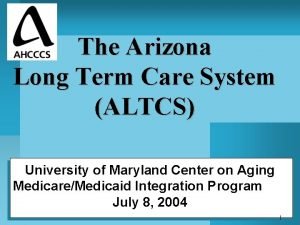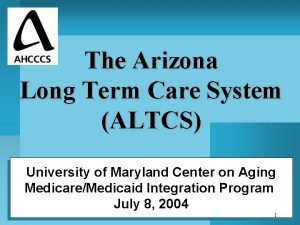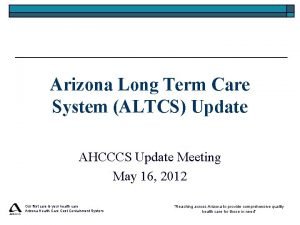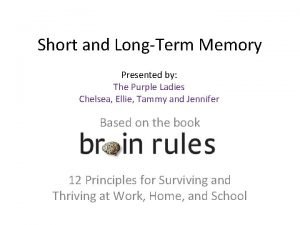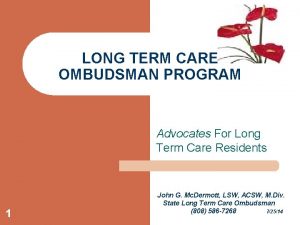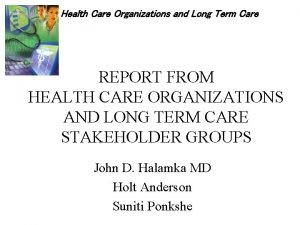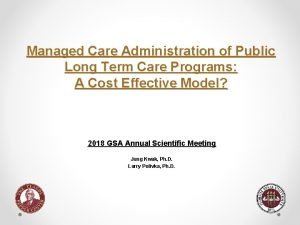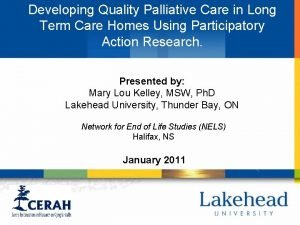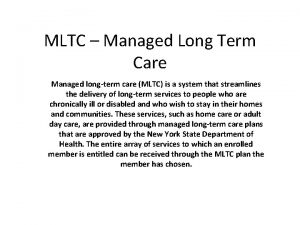LONG TERM CARE INTRODUCTION Long term care is





















































- Slides: 53

LONG TERM CARE

INTRODUCTION: • Long term care is to assist people with support services such as activities of daily living like dressing, bathing and using the bathroom. • Long term care can be provided at home, in the community, in assisted living or in nursing homes.

DEFINITION: • Long term care refers to the care of patients for a time period greater than 30 days. • Long term care is a variety of services that includes medical and non-medical care to people who have a chronic illness or disability. Long term care helps meet health or personal needs.

CLIENTS NEEDING LONGTERM CARE: • Severely developmentally disabled and mentally impaired. • Have physical deficits requiring continuous medical or nursing management (e. g. Alzheimer’s disease). • Other adults who can no longer live alone, who needs continuous supervision, who has three or more ADL disabilities, or who is frail.

TYPES OF LONG-TERM CARE: • Long term care ranges from some scheduled help around the house to 24 hour care in a nursing home. • The purpose of long term care is to help to maintain as much independence as possible without compromising safety.

1. Home care: • Home care includes medical care – usually nurses who come to one’s home if one can’t go out. But this category of long term care can also include help around the home. • Home health aides or personal care service workers can visit daily or as needed to help in bathing and get dressed.

2. Adult care: • Adult care programme are a type of long term care that offers social interaction and meals from one to five days a week. • Some adult care programmes provide transportation to and from the care centre. • Activities often include exercises, games, trips art and music. • Some adult care programmes offer medical services, such as help taking medications or checking blood pressure

3. Senior housing: • It is for the one who can no longer live in a house but doesn’t need continuous long term care, then one might consider senior housing or retirement housing. • This type of housing is often rental apartments that have been adapted for seniors, including railings installed in the bathrooms and power outlets placed higher on the walls.

• Other services offered by senior housing communities include meals, transportation, housekeeping, and activities.

4. Assisted living: • Consider assisted living if one need more help than senior housing offers but still want to remain as independent as possible. • Assisted living staff can help residents take medications on schedule, help with bathing and dressing, and provide some medical care. • Some assisted living facilities also have health services such as a medical clinic.

5. Nursing home: • Nursing home offer 24 – hour nursing care if one is recovering from an illness or an injury • They also offer end of life care. Personal care for bathing, dressing and going to the bathroom also is available at nursing homes. • Nursing home services are for those who need more medical care than other long term care options can offer, such as wound care, rehabilitative therapy.

6. Continuity care retirement community (CCRC): • CCRC offer several levels of care in one setting. • They enable to stay in one place for the rest of life rather than moving each time needing a new level of care.

• When one need more help with daily activities, one can move to the assisted living area. For more care, one can go to the CCRC’s on site nursing home.

NURSING RESPONSIBILITIES IN LONG TERM CARE FACILITIES: ASSESSMENT CARE PLANNING COMMINICATION CARE GIVING MANAGEMENT

HOLISTIC NURSING IN LONG TERM CARE FACILITIES: Nurses can promote holistic care in long term care facilities by: • Assisting residents to achieve a higher potential of functioning. • Supporting residents in their efforts to promote health and prevent complications.

• Learning about the unique life stories of residents. • Ensuring that residents receive care that is consistent with their values and beliefs and respecting cultural differences. • Aiding residents and families in discovering meaning in health status and in life and death. • Strengthening residents’ abilities to live in harmony with their health conditions.

• Assisting residents in maintaining their connections with family, friends and the community with in outside the facility. • Helping residents boost their natural healing abilities. • Facilitating hope and a sense of purpose in resident’s lives. • Supporting residents as they respond to their spiritual identity or relate to a higher power.

• Providing a nurturing and healing care giving environment. • Offering opportunities for residents to experience joy and satisfaction. • Protecting residents from threats to their health or well being and promoting highest quality of life. • Adhering to accepted standards of nursing practice.

ADVANTAGES AND DISADVANTAGES:

AMBULATORY HEALTH CARE

DEFINITION: • Ambulatory care nursing includes those clinical, management, educational and research activities provided by registered nurses for and with individuals who seek care and assistance with health maintenance and/or health promotion.

CHARACTERISTICS OF AMBULATORY CARE NURSING: The following factors have been identified as characteristics of ambulatory care nursing: • • Nursing autonomy Client advocacy Skilful, rapid assessment Holistic nursing care

• Client teaching • Wellness and health promotion • Co-ordination and continuity of care • Long-term relationships with clients and families • Telephone triage, instruction and advise

• Client and family control as major caregivers, users of the health care system, and decision makers regarding compliance with care regimen. • Collaboration with other health care providers • Case management

CHALLENGES FOR NURSES: • Visit encounters are short, the number of client visits per day is great, and the assessment time is compressed. • Control of care and treatment modalities is in the hands of the client and family, not the health care provider.

• In ambulatory care, many members of the health care team work together and their roles often do not have clear boundaries. • In ambulatory care, contacts with the nurse are frequently maintained through communication devices such as the telephone and computer.

• Ambulatory care nurses need highly developed assessment and communication skill, as well as critical thinking and judgement, in order to interpret data and to refer the client for appropriate follow up. • There is constant pressure to increase efficiency and effectiveness of care.

CONCEPTUAL MODELS THAT INFLUENCE AMBULATORY CARE NURSING PRACTICE: THE CLINICAL MODEL LEVELS OF PREVETION MODEL PRIMARY HEALTH CARE & MANAGED CARE MODELS

THE CLINICAL MODEL: • Most health policy experts agree that the current health care system is based on the clinical or medical model. • In this model, health is conceptualized as the absence of the clinical manifestations of disease.

• It is assumed that the body is a machine and that modern medical technology can use physical and chemical interventions to “fix the machine” whenever it is broken. • This has led to great emphasis on expensive, acute care with high technology treatments and relatively little attention to prevention, public health, environmental measures, or personal responsibility for health.

• The traditional nursing role in ambulatory care supported physician control and the clinical model of care delivery. • Although the clinical model has led to great advances in scientific medicine and technology, the focus on body parts rather than the whole, and the lack of emphasis on prevention have been problematic.

LEVELS OF PREVENTION MODEL: • The levels of Prevention model, advocated by Leavell and Clark in 1965, has influenced both public health practice and ambulatory care delivery worldwide. • This model suggests that the natural history of any disease exists on a continuum, with health at one end advanced diseases at the other

• The goal is to maintain a healthy state and to prevent disease and injury. • The model delineates three levels of the application of preventive measures that can be used to promote health and arrest the disease process at different points along the continuum. • The levels of prevention Model is appropriate in all health care settings and in any population group.

Primary prevention: • Primary prevention encompasses both health promotion and specific protection. • Health promotion includes interventions such as health education, information on growth and development, nutrition and exercise as well as the provision of adequate housing, safe working conditions, and other services.

• Specific protection interventions are targeted at specific health risks, injuries, and diseases. For example, immunizations protect against particular infectious diseases; seat belts reduce the injuries in automobile crashes; smoking cessation reduces the risk of cancer s and heart diseases.

Secondary prevention: • Secondary preventive measures include early diagnosis and prompt treatment as well as disability limitation. • Case finding, screening, and treatment of diseases by medical or surgical interventions to arrest the disease process and prevent further complications are all part of secondary prevention. •

Tertiary prevention: • Tertiary prevention is the provision of measures to rehabilitate a person or group so they can maximise their remaining capacities. Cardiac rehabilitation Nurses, physical and occupational therapists, and many home care nurses focus on tertiary prevention. An example of tertiary prevention in the ambulatory surgery recovery room is teaching crutch walking to a client after foot surgery.

PRIMARY HEALTH CARE, PRIMARY CARE, AND MANAGED CARE MODELS: • Primary Health care focuses on the universal right to basic health care. Primary care focuses on integrated care coordinated by one primary provider. Many managed care organizations use primary care providers, such as family practice physicians and nurse practitioners, in a “gatekeeper” function.

AMBULATORY CARE NURSING – CONCEPTUAL FRAMEWORK:

AMBULATORY CARE PRACTICE SETTINGS: • For the purposes of data collection, the National Centre for Health Statistics classifies ambulatory care settings into three main groups: vphysician’s offices, vhospital outpatient departments vhospital emergency departments.

Physician offices: • About 81% of the more than 1 billion annual ambulatory care visits occur in physician’s offices. • Increasingly, physicians are abandoning solo practices and aligning themselves in group practices to consolidate resources to meet the challenges of managed care contracting.

Community hospital outpatient departments: • Community Hospital clinic services began in the letter part of 19 th century and took over the functions of the freestanding dispensaries. • Today, non-profit community hospitals still provide varying amounts of uncompensated care in their outpatient department.

Teaching hospital outpatient departments: • Outpatient departments of teaching hospitals were developed to fulfil the mission of academic health centres; to provide medical and other health professional education, biomedical research and client care services. Clinical services are often organized around medical speciality areas for the convenience of providers.

Health maintenance organizations: • HMOs began more than 50 years ago. HMOs provide a defined population with a stated range of services through the prepayment of an annual or monthly capitation fees. • HMOs are systems of care that integrate the insurance and payment mechanisms and the actual delivery of the health care services.

Emergency Departments: • Almost 10. 6% of ambulatory care visits are provided in EDs. • Because EDs are organized according to the clinical model and are set up to meet acute care needs, they are far from the ideal place to provide primary care services.

Other ambulatory care settings: • • Nurse-managed Center or Nursing Center Government funded public health clinics Community health centers Homeless shelters School based health centers Community based organizations Private non-profit organizations

AMBULATORY CARE INTERDISCIPLINARY TEAM: • Nurses working in ambulatory settings are members of an interdisciplinary team. • They work collaboratively with physicians, midlevel providers, such as nurse practitioners, nurse midwives, and physician assistants, medical assistants, nurse assistants, clerks, receptionists etc.

PROFESSIONAL AND LEGAL CONSIDERATIONS: STANDARDS OF CARE CERTIFICATION REGULATORY COMPLIANCE COMPETENCE MULTISTATE LICENSURE

• 9 standards : • Structure and organization of ambulatory care Nursing • Staffing in ambulatory care • Competency • Ambulatory nursing practice • Continuity of care • Ethics and patient’s Rights • Environment • Research • Quality management

SUMMARY

LONG TERM CARE: • • DEFINITION CLIENTS NEEDING LONG TERM CARE TYPES OF LONG TERM CARE NURSING RESPONSIBILITIES HOLISTIC NURSING ADVANTAGES DISADVANTAGES

AMBULATORY CARE • • DEFINITION CHARACTERISTICS CHALLENGES CONCEPTUAL MODELS CONCEPTUAL FRAME WORK MULTI-DISCPLINARY TEAM PROFESSIONAL AND LEGAL CONSIDERATIONS

 Short medium and long term planning in education
Short medium and long term planning in education Long term memory vs short term memory
Long term memory vs short term memory Short term hr planning
Short term hr planning Difference between long term and short term liabilities
Difference between long term and short term liabilities Difference between long term and short term liabilities
Difference between long term and short term liabilities Good short term goals
Good short term goals Research paper on financial planning and forecasting
Research paper on financial planning and forecasting Long and short
Long and short Once upon a time there was a little man
Once upon a time there was a little man Wisconsin long term care partnership program
Wisconsin long term care partnership program Arizona long term care system (altcs)
Arizona long term care system (altcs) Arizona long term care system (altcs)
Arizona long term care system (altcs) Ahcccs altcs
Ahcccs altcs Ct mutual aid plan
Ct mutual aid plan Primary secondary tertiary care definition
Primary secondary tertiary care definition In my understanding
In my understanding Site:slidetodoc.com
Site:slidetodoc.com Position to term rule worksheet
Position to term rule worksheet Min term max term
Min term max term Rules in finding the nth term
Rules in finding the nth term Term to term rule
Term to term rule Long term financing
Long term financing English 11 unit 10
English 11 unit 10 Long term scheduler
Long term scheduler Dts city pairs
Dts city pairs Mts disability
Mts disability When was the loom invented
When was the loom invented The long-term future of particle accelerators
The long-term future of particle accelerators What are the causes of world war 2
What are the causes of world war 2 Long term causes of world war 1
Long term causes of world war 1 Nstu bereavement days
Nstu bereavement days Debentures advantages and disadvantages
Debentures advantages and disadvantages Long-term finance
Long-term finance Long term memory examples
Long term memory examples Physical activities done at home
Physical activities done at home Long-term incentive plan examples
Long-term incentive plan examples The persistence of learning over time
The persistence of learning over time Long term potentiation
Long term potentiation Long term storage and retrieval
Long term storage and retrieval Bonds payable long term liabilities
Bonds payable long term liabilities Long-term notes payable
Long-term notes payable Bonds payable classification
Bonds payable classification Long term evolution - advanced
Long term evolution - advanced Long term effects of anorexia and bulimia
Long term effects of anorexia and bulimia Is lipid long term energy
Is lipid long term energy Long term debt ratio
Long term debt ratio Effects of the industrial revolution
Effects of the industrial revolution Flying shuttle noon at ngayon
Flying shuttle noon at ngayon Long term potentiation
Long term potentiation Long term goals examples
Long term goals examples Goal setter definition
Goal setter definition Long term memory chart
Long term memory chart Franchise amortization
Franchise amortization Euro btp future
Euro btp future










